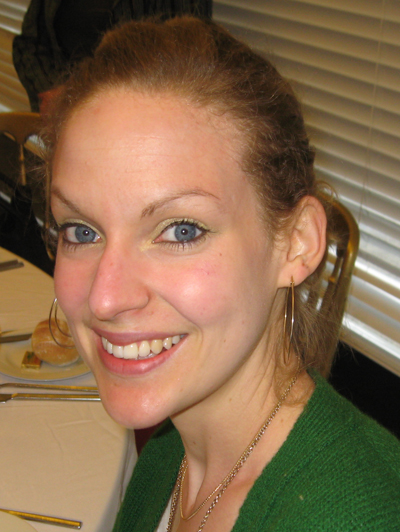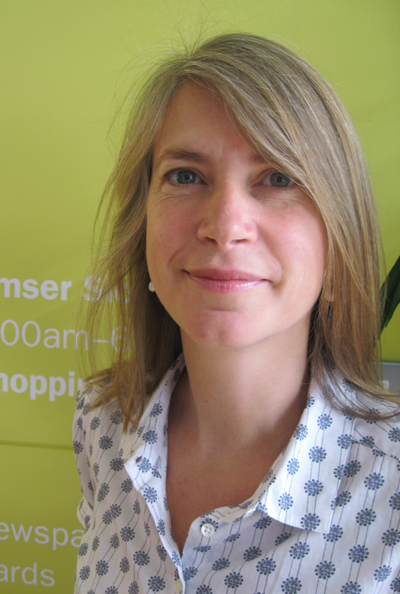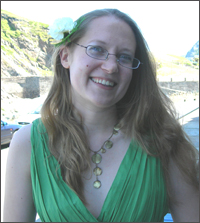Student Bursary Award Reports:
Annalise Harvey
The Costume Society Symposium in Cardiff, July 2008:

As a Costume Designer, and final year MA student, the symposium this year
was of particular interest to me in my ongoing studies.
What fascinated me from the varied
programme of enlightening papers, were the many ways that Dress can be seen as Costume, both
on and off the stage. Rosemary Harden's paper on Margot Fonteyn was of particular interest
to me in this respect, having worked predominantly as Designer for Ballet since 2003.
In many
ways the range of speakers topped and tailed my personal experience of designing as it was
watching the wonderful work of John Bright that, as a teenager, powered my drive to do what
I do today. He gave a real insight into the industry and Lindsay Evans Robertson's brilliant
interview covered everything I ever wanted to ask!
Reflecting on the weekend, and thinking
about what was at its core, I have found a new approach to designing. More than one speaker
described a 'hands on' with the actor. Starting with real clothes and fitting sessions, they
can then get a clear sense of shape, proportion, colour and tone. These sessions work as inspiration
and I was surprised by the general consensus that the drawings could be considered of lesser
importance in the development work using this method.
As a result, I have found a new way
into my thesis work, which I also see now builds on the approach I developed during the Yarwood
project. For this alone, my attendance at the Symposium was invaluable and I would like to
extend my heartfelt thanks to the Society for making it possible and for welcoming me so warmly.
Jane Hattrick University of Brighton
The Costume Society Symposium in Cardiff, July 2008: What did it mean to me?

‘Dress and Performance' was the perfect forum to present my research on Norman Hartnell’s dress designs for the stage,
a hitherto under-examined aspect of the couturier’s work. Being awarded the Student Bursary
meant that I could attend the full range of papers over the course of the weekend.
I was impressed
with the combination of extreme professionalism, the organisation of the event and the quality
of the speakers. The atmosphere of friendliness, support, and the genuine interest delegates
had both in each other’s work and in the work of the talented students was inspiring. As the
weekend progressed and we shared meals and coffee breaks, conversations revealed a depth of
knowledge and experience in so many of the delegate’s lives, which was quite extraordinary.
As the papers progressed on Saturday links between them developed, creating layers of context
for my own paper. Sarah Woodcock discussed the complex factors that ‘govern dance costumes’
such as the effects of harsh lighting, sweat, and extreme movement on the garments and the
need to omit beaded decoration at the waist on women’s costumes due to the practical problems
of partnering. Did Hartnell consider these issues when he designed costumes for the West End
revue in the 1940s? Sarah also showed us examples of sketches, making observations that could
equally be applied to Hartnell’s sketched designs, addressing issues such as why designers
rarely draw the back of the costume and how Oliver Messel reproduced his designs on similar
figures posed in the same positions ‘endlessly’, producing his sketches as ‘blueprints for
the designer’, not as works of art.
Rosemary Harden discussed the mutually beneficial relationship
between Margot Fonteyn and Christian Dior, which could be usefully compared to similar relationships
that Hartnell had with the famous actresses of his day, including Gertrude Lawrence. And Peter
Farrer’s paper on the early history of the ADC and the undertaking of women’s roles by the
young male students at Cambridge presented me with some historical context for Hartnell’s
own female impersonation at Cambridge in the 1920s. The discovery that COSPROP holds some
Hartnell gowns for Queen Mary in their collection as ‘important documents’ was also an exciting
revelation.
Attending this conference enhanced my knowledge of all aspects of costume design
for performance from the perspective of the maker, the academic and the curator. These links
made between other speaker’s research and my own and the contacts made with so many knowledgeable
and encouraging delegates only served to underline how important attending this symposium
was for me. I would like to thank every member who contributes funds to the Society for my
Student Bursary, and also to thank Linda Richards as Symposium Co-ordinator and Liz Booty
as Student Bursary Co-ordinator. Thanks also to the kind person who covered my travel expenses.
Final thanks go to Valerie Cumming, whose recently received personal letter thanking me for
my contribution to this year’s symposium underlines for me what a particular special and unique
organisation the Costume Society is.
Katy May:
Symposium Report 2007

What did I get out of attending the Costume Society
Symposium 2007?
Being awarded a bursary for the symposium meant quite simply that
I was able to attend. Writing this short report is such a small thing to give back
considering the wonderful weekend I was treated to in Newcastle so I hope I am able
to adequately express what I have taken away from the experience and how valuable
it is too me.
The symposium was a weekend of highlights from meeting and chatting
to those who have worked with the most wonderful of museum collections, written
the books and articles that have shaped dress history and inspired me; to visiting
the North Country for the first time and seeing the work of the talented young designers
and of course enjoying the series of lectures.
Whether using purely archival or
object-based approaches or a combination of methodologies the lectures made clear
that studying the dress of town and country is a rewarding and effective way of
exploring changing cultural and social landscapes and of understanding changing
perspectives.
The interaction between town and country lives came across in all
the lectures with the only fundamental difference between town and country dress
appearing to be the importance of practicality in country clothing.
I applied for
the bursary to attend the symposium because this year’s theme of town and country
struck a cord with the research for my MA dissertation.
I am looking at a collection
of late C20th clothing and accessories that belonged to a married couple Hubert
and Winifred Tobitt who after 55 years of marriage died within a month of each other
in 1987. They farmed in the heart of the Surrey countryside and had a great love
of and involvement with horse racing.
Alongside this country life has been an ongoing
interaction with London which is best characterised by the fact that they met through
Hubert’s sister who worked with Winifred and her mother at Harrods. Winifred retained
her Harrods discount and this connection to Harrods is found in the clothing and
accessories that remain in the possession of the family.
There were many parallels
to be found between the Tobitt material and the research being presented in the
lectures. In particular the study of Frances Farquarson through her wardrobe presented
by Christine Rew, this collection is contemporary to the items in the possession
of the Tobitt family. Although the social background is very different many of the
circumstances surrounding and issues related to its survival resonate within my
research.
The connections to my dissertation are not all that I have taken away
with me. I felt incredibly welcomed by everyone and discovered that it really is
a very small world! Talking to as many people as possible while daunting was incredibly
worthwhile and I feel as though I made connections which will continue to help me
in my study of dress.
Charlotte Nicklas:
Symposium Report 2007
As a PhD student researching nineteenth-century dress at the University of Brighton,
I was delighted to receive a student bursary to attend this year’s Costume Society
Symposium, ‘Town and Country Style,’ held in Newcastle and County Durham.
I decided to attend the add-on day
at Bowes Museum, held the day before the official start of the conference. Although
we departed from Newcastle for Bowes in truly miserable weather, by the afternoon
the sun had appeared and we enjoyed breathtaking views of the countryside surrounding
the museum.
At the museum, we were luckily able to see part of ‘Fine and Fashionable:
Lace from the Blackborne Collection,’ the recent exhibition which showcased one
of the world’s most important collections of lace. We visited the conservation laboratory
and were asked our opinions about treatment and display of objects in the future
dress galleries. We also saw several objects from the museum’s excellent collection,
including a bright green ‘croquet’ dress from the 1860s which featured an ingenious
skirt-lifting mechanism. This piece was of special interest to me, as my research
focuses on the development of new textile dyes in the mid-nineteenth-century.
The
papers presented on Saturday and Sunday ranged widely across time, but all addressed
issues of locality in dress, from Kay Staniland’s discussion of the advertisements
and engravings presented to the eighteenth-century Newcastle readership of the Ladies’
Own Memorandum Book to Christine Rew’s presentation of bright (and warm!) mohair
ensembles, variety of tartans, and tweed suits in the wardrobe of Frances Farquharson
of Invercauld.
The fashion design awards presentation on Saturday afternoon featured
a fashion show of work by students at University of Northumbria’s School of Design.
Using textiles provided by Barbour and inspired by ‘Tyne and Country’, the students
presented innovative ensembles to an enthusiastic audience.
Leaving the town for
the country once again on Sunday, we travelled to Beamish Open Air Museum.
We visited
the reconstructed 1913 town of Beamish and the nearby colliery village, as well
as viewing objects from the museum’s collection. We saw fascinating early twentieth-century
trade catalogues and mid- to late-nineteenth century dresses and workwear.
Of particular
interest to me were a black and bright purple striped dress trimmed with purple
lace and a bright blue faille dress—the museum’s records indicate that the last
was a dairymaid’s wedding dress, on which she spent five shillings.
All the conference
delegates were very friendly and encouraging, eager to share their knowledge and
stories over meals and on coach journeys. Learning of the riches of the Beamish
and Bowes collections in mid-nineteenth-century dress was happy news to me and I
hope to make a return journey north soon!